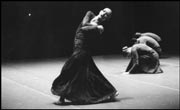PACIFIC NORTHWEST BALLET’S “THE BEST OF PNB”
Opera House, Seattle Center, 292-ARTS, $15-$115 7:30 p.m. Thurs.-Fri.; 2 p.m. and 7:30 p.m. Sat.; 1 p.m. Sun. Sept. 27-30
AMERICAN BALLET THEATER’S “GISELLE”
Paramount Theatre, 911 Pine, 292-ARTS, $20-$100 7:30 p.m. Wed.-Fri.; 2 p.m. and 8 p.m. Sat.; 2 p.m. Sun. Sept. 26-30
OVER THE COURSE of a normal year, Pacific Northwest Ballet might perform 15 or 16 different works. There’s “Nutcracker” in the middle of the season, one or two other full-evening ballets, and the rest of their concerts with three or maybe four different dances in each program. For a company with close to 100 works in its books, it would take years to see all of them at this rate. But in its opening program for this season, PNB is dancing excerpts from 14 ballets, giving us a kind of Whitman’s Sampler of their repertory.
Although it’s standard practice in ballet to present excerpts of complete works, an entire evening of samples can be overwhelming, more like a promotional video for the season than a specific performance. All told the curtain goes up or down 30 times a show at the Opera House.
Since many of the choices were actually drawn from a subscriber survey, the program wasn’t specifically designed to represent PNB’s aesthetic, but it does do that remarkably well. Heavily weighted towards 20th century works, particularly the neoclassicism of George Balanchine and crossover works combining ballet with influences from ethnic and modern dance sources, the PNB repertory is an excellent example of what a ballet company can look like at the beginning of the 21st century.
With parts of five different works on the program, Balanchine’s influence is obviously a strong one and is reflected in the powerful athletic competence of the dancers. Lisa Apple and Julie Tobiason surged and flowed through the first movement of “Serenade” that opened the evening, modulating their force with the changing intensity of the ballet, and at the end of the program, Louise Nadeau was a sparkling Liberty Bell in the finale of “Stars and Stripes.” Company newcomer Valeri Hristov seemed extremely comfortable in the first pas de trois from “Agon,” with its combination of slouchy pacing and quicksilver changes of shape.
The finely articulated power of these works is reflected in other parts of the repertory. Ariana Lallone continues to use her height to her advantage, whether striding through “Stars and Stripes” or writhing exquisitely in Nacho Duato’s signature combination of modern dance and ballet seen in “Jardi Tancat.” Melanie Skinner and Casey Herd’s duet from William Forsythe’s “in the middle, somewhat elevated” has lost none of its slash-and-burn quality, coming close enough to violence to make us twist a bit without losing its choreographic integrity.
Among these works are several others that illustrate the breadth of the company. Ballets by artistic director Kent Stowell serve the dancers well, especially the smart and sexy “Whip-Poor Will” duet from his “Silver Linings.” Marius Petipa’s “Le Corsaire” was the evening’s sole nod to ballet’s late 19th century classical period, while Val Caniparoli’s “Lambarena” combines African traditions with ballet’s European roots.
ACROSS TOWN at the Paramount, the curtain will move just four times for American Ballet Theater’s production of “Giselle.” As the ads say, ABT is one of the premiere companies in the U.S. Though their contemporary repertory is fully as broad as PNB’s, for their return to Seattle they’ve chosen to present a work central to the history of ballet. “Giselle” is the preeminent work from the romantic period of the middle 19th century, a ballet in which dance is used most persuasively both as a medium of expression and a metaphor for that expression.
Its story of a young peasant woman who is wooed and then betrayed by a nobleman in disguise is full of opportunities for dances, from the standard happy peasants on the village green to the duets for Giselle and Alberecht, her ill-fated lover, and the ghostly ensemble work of the second act, set in the world of the dead. ABT has been performing “Giselle” since its founding in the 1940s, and the company brings significant depth to the drama of the work as well as the dancing. Julie Kent, who is at an apex in her career, will perform the title role on opening night and has received great notices for the poignancy of her interpretation, but it’s in the totality of the program that “Giselle” makes its biggest impact. There we see dance as both an expression of love and hate, as a weapon and as a shield, as a mode of destruction and as a tool of redemption.








